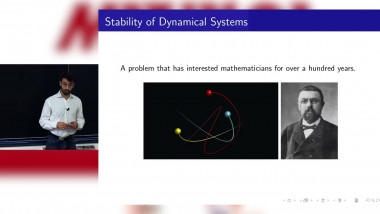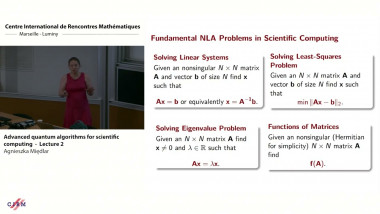When is the resolvent like a rank one matrix ?
Let $A$ be a square matrix. The resolvent, $(A-z I)^{-1}, z \in \mathbb{C}$, plays an important role in many applications; for example, in studying functions of $A$, one often uses the Cauchy integral formula,$$f(A)=-\frac{1}{2 \pi i} \int_{\Gamma}(A-z I)^{-1} f(z) d z$$where $\Gamma$ is the boundary of a region $\Omega$ that contains the spectrum of $A$ and on which $f$ is analytic. If $z$ is very close to a simple eigenvalue $\lambda$ of $A$ - much closer to $\lambda$ than to any other eigenvalue of $A$ - then $(A-z I)^{-1} \approx \frac{1}{\lambda-z} x y^²$, where $x$ and $y$ are right and left normalized eigenvectors of $A$ corresponding to eigenvalue $\lambda$. It is sometimes observed, however, that $(A-z I)^{-1}$ is close to a rank one matrix even when $z$ is not very close to an eigenvalue of $A$. In this case, one can write $(A-z I)^{-1} \approx \sigma_1(z) u_1(z) v_1(z)^²$, where $\sigma_1(z)$ is the largest singular value of $(A-z I)^{-1}$ and $u_1(z)$ and $v_1(z)$ are the corresponding left and right singular vectors. We use singular value/vector perturbation theory to describe conditions under which $(A-$ $z I)^{-1}$ can be well-approximated by rank one matrices for a wide range of $z$ values. If $\lambda$ is a simple ill-conditioned eigenvalue of $A$, if the smallest nonzero singular value of $A-\lambda I$ is well-separated from 0 , and if a certain other condition involving the singular vectors of $A-\lambda I$ is satisfied, then it is shown that $(A-z I)^{-1}$ is close to a rank one matrix for a wide range of $z$ values. An application of this result in comparing bounds on $|f(A)|$ is described [1] for example, in studying functions of $A$, one often uses the Cauchy integral formula,$$f(A)=-\frac{1}{2 \pi i} \int_{\Gamma}(A-z I)^{-1} f(z) d z$$where $\Gamma$ is the boundary of a region $\Omega$ that contains the spectrum of $A$ and on which $f$ is analytic. If $z$ is very close to a simple eigenvalue $\lambda$ of $A$ - much closer to $\lambda$ than to any other eigenvalue of $A$ - then $(A-z I)^{-1} \approx \frac{1}{\lambda-z} x y^²$, where $x$ and $y$ are right and left normalized eigenvectors of $A$ corresponding to eigenvalue $\lambda$. It is sometimes observed, however, that $(A-z I)^{-1}$ is close to a rank one matrix even when $z$ is not very close to an eigenvalue of $A$. In this case, one can write $(A-z I)^{-1} \approx \sigma_1(z) u_1(z) v_1(z)^²$, where $\sigma_1(z)$ is the largest singular value of $(A-z I)^{-1}$ and $u_1(z)$ and $v_1(z)$ are the corresponding left and right singular vectors.We use singular value/vector perturbation theory to describe conditions under which $(A-$ $z I)^{-1}$ can be well-approximated by rank one matrices for a wide range of $z$ values. If $\lambda$ is a simple ill-conditioned eigenvalue of $A$, if the smallest nonzero singular value of $A-\lambda I$ is well-separated from 0 , and if a certain other condition involving the singular vectors of $A-\lambda I$ is satisfied, then it is shown that $(A-z I)^{-1}$ is close to a rank one matrix for a wide range of $z$ values. An application of this result in comparing bounds on $|f(A)|$ is described [1].





















